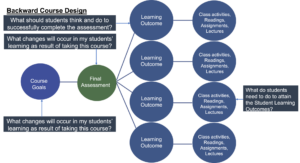Backward Design
Typically, instructors approach the design of their courses with a forward-focused mindset. This means that they create learning objectives, assessments, and activities based on the question “How can I teach this effectively?” rather than considering “How will my students learn this best?” They begin by designing course activities, then develop assessments based on those activities, and finally try to establish connections to their learning objectives. According to this perspective, learning is seen as the activity itself, disregarding the fact that learning is the outcome of meaningful engagement with carefully selected activities.
On the other hand, the backward design framework proposes that learning objectives should be the initial focus, followed by assessments, and then teaching/learning activities. By working in reverse order, this approach emphasizes the deliberate planning of course design and the purposeful nature of assessments. When assignments and assessments are firmly grounded in explicit learning objectives, instruction becomes more organized and transparent. Moreover, structured, and purpose-driven instruction eliminates the possibility of assigning or completing activities merely for the sake of doing them.

First Stage – Identify Intended Results (Learning Goals)
During the initial stage of the Backward Design framework, instructors will explore the following aspects:
What materials should students interact with?
This content holds the least priority. While it is worth mentioning and becoming familiar with, the main objective of the course does not revolve around the knowledge derived from it.
What knowledge and skills should students achieve mastery in?
This level of engagement is crucial for the practical application of the course material. It includes information such as facts, concepts, principles, processes, strategies, and methods that students should learn and be capable of employing upon completing the course.
What are the essential ideas and understandings that students should retain?
This refers to the underlying reasons or “why” behind the material. It encompasses the content that students should be able to recall, analyze, and apply even after completing the course, allowing them to retain it for a significant period.
Second Stage – Determine Acceptable Evidence (Development of Assessments)
During the second stage of the Backward Design framework, instructors will address the following considerations:
- How can I determine whether students have successfully attained the desired learning outcomes?
- What types of evidence will be deemed acceptable to demonstrate student achievement?
Third Stage – Plan Learning Experiences and Instruction
During the third stage of the Backward Design framework, instructors will assess the following aspects:
- What specific theoretical knowledge and practical skills are necessary for students to effectively accomplish the desired learning outcomes?
- Which activities will best equip students with the required knowledge and skills?
- What should be taught and how should it be taught to facilitate optimal learning?
- Which materials and resources are most suitable for promoting effective teaching and learning outcomes?



